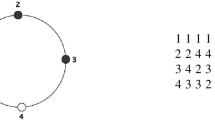Abstract
A P-point ultrafilter over \(\omega \) is called an interval P-point if for every function from \(\omega \) to \(\omega \) there exists a set A in this ultrafilter such that the restriction of the function to A is either a constant function or an interval-to-one function. In this paper we prove the following results. (1) Interval P-points are not isomorphism invariant under \(\textsf{CH}\) or \(\textsf{MA}\). (2) We identify a cardinal invariant \(\textbf{non}^{**}({\mathcal {I}}_{\tiny {\hbox {int}}})\) such that every filter base of size less than continuum can be extended to an interval P-point if and only if \(\textbf{non}^{**}({\mathcal {I}}_{\tiny {\hbox {int}}})={\mathfrak {c}}\). (3) We prove the generic existence of slow/rapid non-interval P-points and slow/rapid interval P-points which are neither quasi-selective nor weakly Ramsey under the assumption \({\mathfrak {d}}={\mathfrak {c}}\) or \(\textbf{cov}({\mathcal {B}})={\mathfrak {c}}\).
Similar content being viewed by others
Notes
In some literature, a summable ideal \({\mathcal {I}}_h\) is defined without requiring that h be monotonic. We choose the current form for simplicity.
We define \({\mathcal {C}}_{\tiny {\hbox {int}}}\) by requiring that all sets A in it have finite y-segments \(A^n\), rather than finite x-segments, due to the fact that in the proof of Lemma 4.1. the function f, as a convention, maps a number from x-axis to a number in y-axis. For keeping consistency, we then introduce the ideals \({\mathcal {I}}_{\tiny {\hbox {selec}}}\) and \({\mathcal {I}}_{\tiny {\hbox {P}}}\) as the reflections of \({\mathcal {E}}\!{\mathcal {D}}\) and \(\hbox {Fin}\times \hbox {Fin}\), respectively, along the diagonal line \(y=x\).
References
Bartoszyński, T., Judah, H.: Set Theory, On the Structure of The Real Line. A. K. Peters (1995)
Baumgartner, J.E.: Ultrafilters on \(\omega \). J. Symb. Log. 2, 624–639 (1995)
Blass, A.: Combinatorial cardinal characteristics of the continuum. In: Foreman, M., Kanamori, A. (eds.) Handbook of Set Theory, pp. 395–489. Springer (2010)
Blass, A., Di Nasso, M., Forti, M.: Quasi-selective ultrafilters and asymptotic numerosities. Adv. Math. 231, 1462–1486 (2012)
Booth, D.: Ultrafilters on a countable set. Ann. Math. Log. 2, 1–24 (1970)
Brendle, J.: Between p-points and nowhere dense ultrafilters. Isr. J. Math. 113, 205–230 (1999)
Brendle, J., Flašková, J.: Generic existence of ultrafilters on the natural numbers. Fundam. Math. 236, 201–245 (2017)
Canjar, R.M.: On the generic existence of special ultrafilters. Proc. Am. Math. Soc. 110, 233–241 (1990)
Di Nasso, M.: Fine asymptotic densities for sets of natural numbers. Proc. Am. Math. Soc. 138, 2657–2665 (2010)
Flašková, J.: Description of some ultrafilters via \(I\)-ultrafilter. In: Proceedings of RIMS, vol. 1619 (2008)
Forti, M.: Quasi-selective and weakly Ramsey ultrafilters. arXiv:1012.4338
He, J., Jin, R., Zhang, S.: Rapid Interval P-point. Topol. Appl. 283(1), 107333 (2020)
Hong, J.Y., Zhang, S.: Cardinal invariants related to the \(I\)-ultrafilters. Sci. Sin. Math. 43(1), 1–6 (2013)
Hong, J.Y., Zhang, S.: Relations between the \(I\)-ultrafilters. Arch. Math. Log. 56(1–2), 161–173 (2017)
Jin, R.: Slow P-point ultrafilters. J. Symb. Log. 85(1), 26–36 (2020)
Ketonen, J.: On the existence of P-points in the Stone-Čech compactification of integers. Fundam. Math. 92(2), 91–94 (1976)
Miller, A.: There are no Q-points in Laver’s model for the Borel conjecture. Proc. Am. Math. Soc. 78(1), 103–106 (1980)
Shelah, S.: Proper and Improper Forcing, 2nd edn. Springer (1998)
Vojtáš, P.: On \(\omega ^*\) and absolutely divergent series. Topol. Proc. 19, 335–348 (1994)
Author information
Authors and Affiliations
Corresponding author
Additional information
Publisher's Note
Springer Nature remains neutral with regard to jurisdictional claims in published maps and institutional affiliations.
Jialiang He: Supported in part by a National Science Foundation of China Grant #11801386. Renling Jin: Supported in part by a collaboration research Grant #513023 from Simons Foundation. Shuguo Zhang: Supported in part by a National Science Foundation of China Grant #11771311.
Rights and permissions
Springer Nature or its licensor (e.g. a society or other partner) holds exclusive rights to this article under a publishing agreement with the author(s) or other rightsholder(s); author self-archiving of the accepted manuscript version of this article is solely governed by the terms of such publishing agreement and applicable law.
About this article
Cite this article
He, J., Jin, R. & Zhang, S. Generic existence of interval P-points. Arch. Math. Logic 62, 619–640 (2023). https://doi.org/10.1007/s00153-022-00853-3
Received:
Accepted:
Published:
Issue Date:
DOI: https://doi.org/10.1007/s00153-022-00853-3




